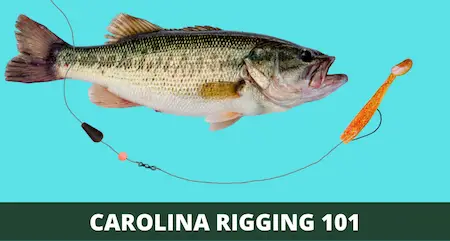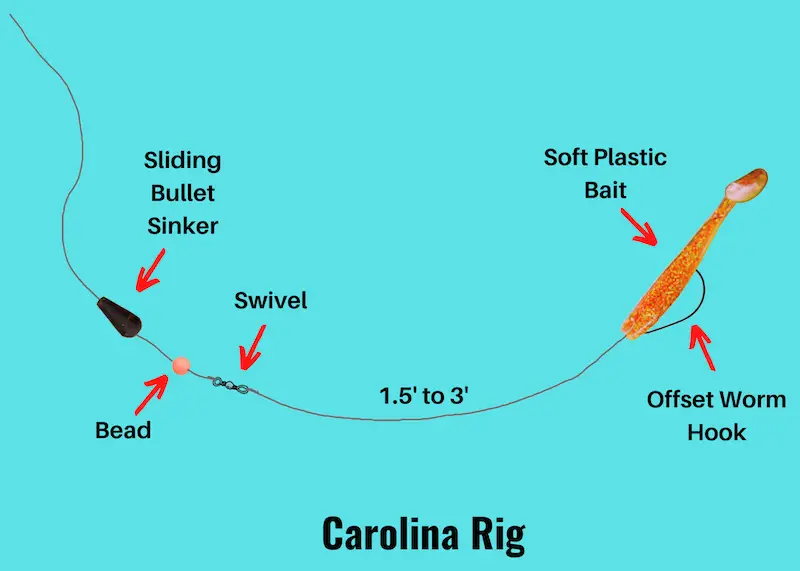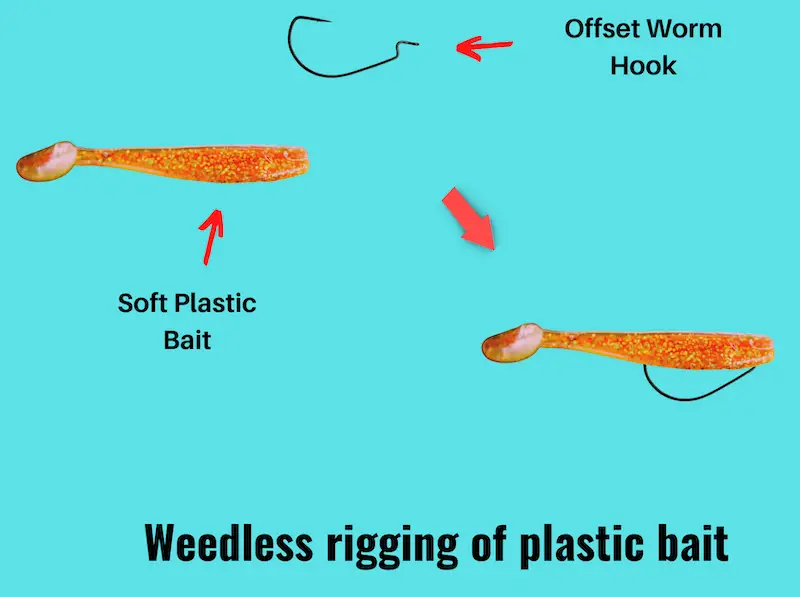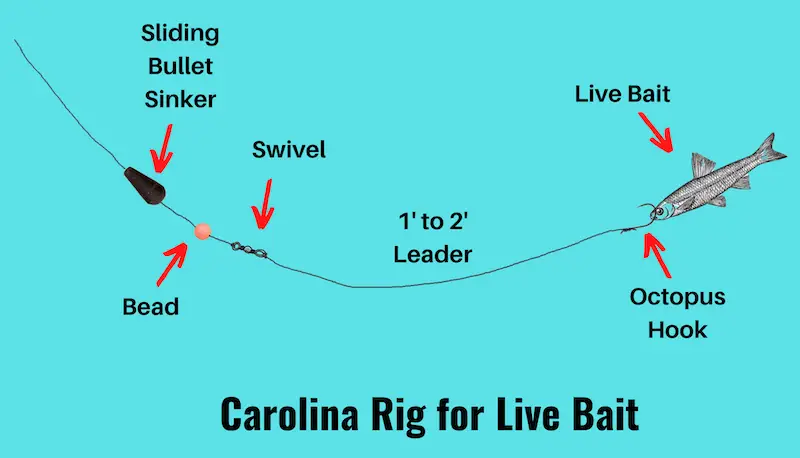Carolina Rig 101 (Setup and How-to Guide with Pictures)
PUBLISHED 03 NOVEMBER 2023
by Robert Ceran
Are you planning to throw a Carolina rig for bass, but aren’t sure how to set it up, or how to fish it for optimal results?
While the Carolina rig is without a doubt one of the most versatile fishing rigs that catches fish anywhere, it can be tricky to set it up and fish it with sufficient finesse for ideal results.
In this article I’ll show you how to set up the Carolina rig, and will also cover what bait to use with it, and how to use it to catch more fish.

What is a Carolina rig (and what is it good for)?
A Carolina rig is a simple bottom fishing rig that consists of a sliding sinker, bead, swivel, leader and hook. And while the Carolina rig is most popular among bass anglers, it can be used for pretty much any kind of fish that feed close to the bottom.
A key advantage of the Carolina rig is its extreme versatility, making it the best all-around rig for bottom fishing available to anglers.
A Carolina rig can be used either from the bank or from a boat, it can be thrown in both freshwater and saltwater, and it can be fished with either artificial lures, cured bait, cut bait, or live bait.
Personally, I always make sure that I have all the components for Carolina rigging in my tackle box whenever I leave home to go fishing, and I think every angler should do the same.
Carolina rig components
Here are the tackle components you’ll need for a Carolina rig:
- 10 to 15 lb test main line (braid or fluorocarbon)
- 6 to 8 lb test leader (fluorocarbon or monofilament)
- 1/4 or 1 oz sliding sinker (egg or bullet sinker)
- Plastic bead
- Size #8 to #5 barrel swivel
- Size #4 to #10 hook
- Soft plastic bait or natural bait

Choosing the right hook type for your Carolina rig depends on what bait you want to use. If you’re planning to use it with soft plastic lures, it’s best to use an offset worm hook (which is also ideal for weedless rigging).
On the other hand, if you’re going to bait the hook of your Carolina rig with live bait or natural bait, it’s better to use an octopus hook or a circle hook.
Choose the strength of your line depending on the size of the fish you’re planning to target with Carolina-rigging. In general, go with the lightest setup possible, but without running the risk of losing big fish due to line breakage.
Choosing the right rod and reel for Carolina rig fishing
I personally prefer using a spinning rod and reel setup for fishing with a Carolina rig, but many of my bass fishing buddies prefer a low profile baitcasting setup.
Catfish anglers, on the other hand, often prefer using a round baitcasting reel with a long 9 or 10 foot rod when fishing a Carolina rig, since this generates the longest casting distances.
When targeting bass or Carolina rigging for walleye, a great all around rod for this purpose should be at least 7 feet long, have a fast action tip and a medium power backbone.
This combination allows you to achieve relatively long casts with your Carolina rig, while still offering enough sensitivity to feel subtle bites through the rod.
How to set up a Carolina rig
One of the key advantages of the Carolina rig is that it’s very easy to set up. With a little practice, you’ll be able to tie it in five minutes or less.
Start by sliding the egg sinker (or bullet weight) onto your braided main line, followed by the plastic bead.
The plastic bead isn’t absolutely essential for Carolina rigging, but I strongly advise using it, as it prevents the weight from getting stuck on the knot at the swivel. This not only keeps the weight sliding smoothly, but also protects the knot from damage by chafing.
The plastic bead also creates a clacking sound when you hop the Carolina rig along the bottom, and many anglers swear that this helps to attract the attention of nearby predatory fish.
Next, tie the main line to one eye of a barrel swivel. Then measure out about 1.5 to 3 feet of your fluorocarbon leader, and tie one end of this to the second eye of the barrel swivel.
Finally, tie your hook of choice to the other end of the leader, add bait to it, and your Carolina rig is ready to go!
How to choose the ideal leader length for a Carolina rig
Typically, the ideal leader length for a Carolina rig is between 18 and 48 inches. A shorter leader is better for casting, while a longer leader is better when dealing with finicky fish, as it will present your bait further away from the weight.
Another thing to keep in mind is that you generally don’t want your bait to be lying on the bottom, but suspended about a foot above the bottom, which looks much more natural to bass and other predators.
In order to achieve this, your Carolina rig needs to have a bait that floats in the water, and a minimum leader length of 18 inches.
What bait should you use with a Carolina rig?
If you’re throwing a Carolina rig for bass fishing, the best baits to use are soft plastics, including plastic worms, swimbaits, flukes, lizards, tubes, grubs, crawfish trailers, and soft plastic jerkbaits.
There is an almost infinite variety of these soft plastics that you can use with a Carolina rig, and you’ll have to do a lot of experimentation to figure out what works best in your fishery.
In my experience, steer away from the standard ones that everyone else is throwing, and invest the time to find more unusual baits that the fish aren’t accustomed to seeing.

If you use an offset worm hook (which is highly recommended), you can use this to thread your soft plastic onto the hook and rig it in a weedless fashion, by embedding the point of the hook inside the body of the plastic bait.
That way your Carolina rig won’t get snagged as easily, and will be able to throw your rig closer to weeds and other cover.
Finally, if you’re using a Carolina rig for catfish instead, the best option is to bait your hook with cut bait or live bait fish.
For this purpose, it’s better to use an octopus or bait keeper hook, although my personal preference is for a circle hook, as that will avoid deep hooking the catfish (the same goes for targeting redfish with this rig).
How to fish a Carolina rig
The most popular way to fish a Carolina rig is by throwing it to promising spots near cover or underwater structure, such as brush piles, laydowns, or grass beds, and then let it sink to the bottom.
When the line goes slack, you’ll know that the sinker has reached the bottom, and at that point you need to take in the slack and start hopping the rig along the bottom as you slowly retrieve it.
How to retrieve your Carolina rig
The Carolina rig is not designed for high speed retrieval, and in my experience it works best if you reel in the line slowly during retrieval, interspersed with frequent pauses.
Another great trick is to periodically jerk the whole Carolina rig up with your rod tip, which creates plenty of commotion when the weight hits the bottom again or smacks into a rock. This vibration attracts nearby largemouth bass to investigate, and when they come closer they’ll find your soft plastic bait.
During the pauses your lure slowly flutters down in the water column, and I’ve found that often the bites come precisely at this point, or right after you start retrieving the rig again.
It’s essential to keep a taut line from the rod to your Carolina rig during retrieval, as that will allow you to feel any tugs, pulls, or vibrations that could signal a bite. With a little practice, you’ll also be able to feel the texture of the bottom and will notice when there are changes in bottom composition.
One of the biggest challenges when fishing with a Carolina rig is to maintain constant contact with the bottom, while managing to avoid getting the sinker snagged on rocks or other cover.
Static fishing with a Carolina rig

If you’re using the Carolina rig with natural bait (such as cut bait for catfish, live bait for walleye, or a Carolina rig setup for trout baited with salmon eggs or power bait), it’s usually best to cast out the baited rig, and then place your rod in a rod holder while you wait for a bite.
You can’t use this static approach when Carolina rigging artificial lures, since they won’t trigger bites unless you give them some motion. But with natural bait you can rely on its scent and texture to tempt fish even if your bait is motionless in the water.
Also, when using the Carolina rig as a live bait fishing rig, even though this tactic is stationary, you can be sure that the live minnow or nightcrawler is dancing around enticingly in the water, which is enough action to trigger strikes from fish.
